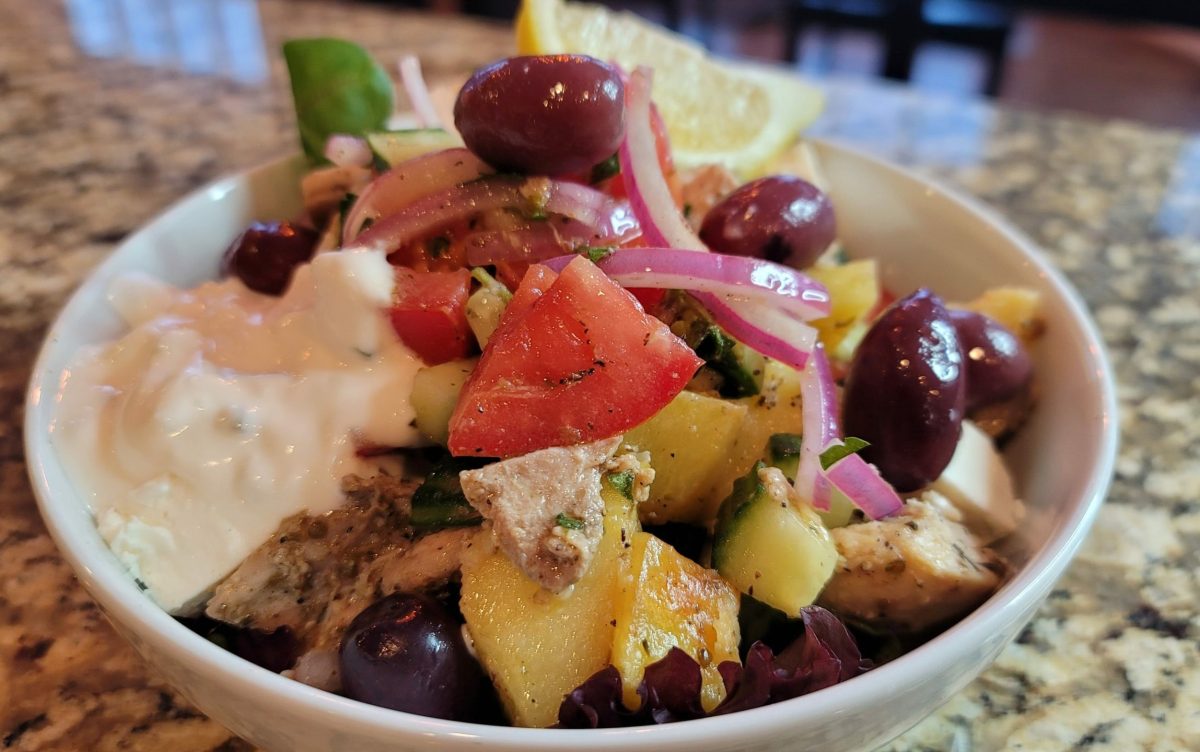Embark on a culinary journey with vibrant, allergen-free Greek-inspired bowls bursting with flavor! These recipes offer delicious and healthy alternatives to traditional Greek dishes, carefully crafted to be free from common allergens while retaining the authentic taste and satisfying textures. We’ll explore three unique variations, each featuring a different protein source – chickpeas, lentils, or tofu – providing a diverse range of nutritional benefits and exciting flavor profiles. Prepare to be inspired by the simplicity and versatility of these bowls, perfect for any dietary restriction or preference.
From detailed step-by-step instructions to insightful allergen substitution guides, this guide equips you with the knowledge and confidence to create these bowls effortlessly. We’ll delve into the art of presentation, showcasing visually stunning arrangements that elevate the dining experience. Discover how to customize these bowls to suit your individual needs, whether you’re a vegetarian, vegan, or simply seeking a healthier and more flavorful meal. Get ready to tantalize your taste buds and nourish your body with these delightful and inclusive recipes.
Step-by-Step Preparation Guide
This guide details the preparation of a vibrant and flavorful allergen-free Greek Lemon Herb Chicken and Quinoa Bowl. Each step is designed to maximize flavor and texture, resulting in a healthy and satisfying meal. The recipe is naturally free from common allergens like gluten, dairy, soy, and nuts.
Ingredients Preparation
Preparing the ingredients beforehand streamlines the cooking process and ensures even cooking. This also allows the flavors to meld beautifully.
- Rinse one cup of quinoa thoroughly under cold water to remove any saponins. Imagine the water running clear, carrying away any potential bitterness.
- In a medium saucepan, combine the rinsed quinoa with two cups of water. Bring to a boil, then reduce heat to low, cover, and simmer for 15 minutes, or until all the water is absorbed and the quinoa is fluffy. The result should be light and airy, not mushy.
- While the quinoa cooks, prepare the chicken. Cut one pound of boneless, skinless chicken breasts into 1-inch cubes. Picture the chicken, uniformly sized, ready for even cooking.
- In a bowl, toss the chicken cubes with two tablespoons of olive oil, one tablespoon of lemon juice, one teaspoon of dried oregano, half a teaspoon of dried thyme, salt, and pepper. The mixture should be fragrant and evenly coated, promising a burst of Mediterranean flavors.
- Chop one cucumber, one red bell pepper, and half a red onion into bite-sized pieces. The vibrant colors will make the bowl visually appealing.
- Wash and roughly chop one cup of Kalamata olives. Their briny flavor will provide a wonderful counterpoint to the chicken and herbs.
- Combine the chopped cucumber, bell pepper, red onion, and olives in a separate bowl. The mixture should be colorful and ready to be incorporated into the bowl.
Cooking the Chicken and Assembling the Bowl
This section Artikels the cooking of the chicken and the final assembly of the flavorful Greek bowl. Proper cooking ensures tender chicken, while the assembly focuses on creating a visually appealing and balanced meal.
- Heat a large skillet over medium-high heat. Add the marinated chicken and cook for 5-7 minutes, or until browned and cooked through. The chicken should be golden brown, indicating proper searing.
- Once the quinoa is cooked, fluff it with a fork. The quinoa should be light and airy, not clumped together.
- To assemble the bowls, divide the cooked quinoa evenly among four bowls. Imagine four perfectly portioned bowls, each a canvas for a delicious creation.
- Top the quinoa with the cooked chicken, followed by the cucumber, bell pepper, red onion, and olive mixture. The layers should be visually distinct yet harmonious.
- Drizzle each bowl with an extra tablespoon of olive oil and a squeeze of fresh lemon juice. A final touch of lemon brightens the flavors and adds a fresh aroma.
- Garnish with fresh oregano or parsley sprigs for an extra touch of freshness and visual appeal. The vibrant green herbs add a final layer of color and texture.
Allergen-Free Ingredient Substitutions
Creating delicious and authentic-tasting Greek dishes without common allergens requires careful ingredient selection and substitution. Many traditional Greek recipes rely on ingredients like dairy, wheat, nuts, and sesame seeds, all of which can trigger allergic reactions. Fortunately, with a little creativity, you can easily adapt these recipes to be enjoyed by everyone. This section will explore common allergens in Greek cuisine and offer suitable replacements that maintain the vibrant flavors and textures you expect.
Several common allergens frequently appear in traditional Greek recipes. Dairy products, particularly in creamy sauces and dips like tzatziki, are a primary concern. Wheat, a staple in breads, pastries, and even some thickening agents, poses another challenge. Nuts, especially almonds and pistachios, are often used in desserts and savory dishes. Finally, sesame seeds, a component of many breads and tahini-based sauces, are a significant allergen for some individuals.
Dairy-Free Alternatives in Greek Cuisine
Dairy is prevalent in many Greek dishes, from creamy sauces to feta cheese. Fortunately, there are numerous delicious substitutes available. Coconut cream, cashew cream, or even a well-made vegan yogurt can create rich and creamy textures in sauces and dips, mirroring the richness of traditional dairy-based recipes. For feta, consider using a high-quality vegan feta made from tofu or other plant-based ingredients. These substitutes offer comparable flavor profiles while remaining entirely dairy-free.
Gluten-Free Adaptations for Greek Recipes
Gluten, found in wheat, is a key component in many traditional Greek breads and pastries. Fortunately, gluten-free flours, such as almond flour, rice flour, or a blend of gluten-free flours, can be used as substitutes. These alternatives might require slight adjustments in the recipe, such as adding extra binding agents (like xanthan gum) to achieve the desired texture. Remember that gluten-free baking often requires different techniques and timing adjustments to achieve optimal results. Experimentation and recipe adjustments are key to success.
Nut-Free and Sesame-Free Options
Nuts and sesame seeds are common ingredients in Greek desserts and sauces, adding texture and flavor. For those with nut allergies, sunflower seeds, pumpkin seeds, or even toasted chickpeas can provide a satisfying crunch. Similarly, tahini, often made from sesame seeds, can be replaced with sunflower seed butter or a combination of other seed butters to create similar creamy textures in sauces and dressings. These substitutes might subtly alter the flavor profile, but they provide safe and delicious alternatives.
Allergen Substitution Table
| Allergen | Potential Substitute | Impact on Flavor | Impact on Texture |
|---|---|---|---|
| Dairy (e.g., feta, yogurt) | Vegan feta (tofu-based), coconut cream, cashew cream, vegan yogurt | Slightly different, but still savory and tangy; can be adjusted with herbs and spices. | Can be similar in creaminess, depending on the substitute. |
| Wheat (in bread, pastries) | Almond flour, rice flour, gluten-free flour blends | Subtle change in flavor; may require additional flavoring. | May be slightly denser or crumblier than wheat-based products. |
| Nuts (almonds, pistachios) | Sunflower seeds, pumpkin seeds, toasted chickpeas | Different nutty flavor profile; may require additional seasoning. | Similar crunch, but different mouthfeel. |
| Sesame Seeds (in tahini) | Sunflower seed butter, other seed butters | Less intense nutty flavor; adjust seasoning accordingly. | Similar creamy texture. |
Adapting Greek Dressings and Sauces for Allergen-Free Diets
Traditional Greek dressings and sauces, like tzatziki, often contain dairy and nuts. To create allergen-free versions, replace yogurt with a dairy-free alternative like coconut yogurt or cashew cream. Similarly, if a recipe calls for nuts, substitute with seeds or omit them altogether, adjusting the seasonings to compensate for the change in flavor profile. Experimentation is key to achieving the desired taste and texture. For example, a dairy-free tzatziki can be made using a vegan yogurt base, cucumber, garlic, dill, and lemon juice. The resulting sauce will retain the refreshing tanginess of the original, while remaining completely free from dairy.
Presentation and Serving Suggestions

Transforming your allergen-free Greek bowls from delicious creations into visual feasts is key to elevating the dining experience. Careful consideration of color, texture, and plating techniques can dramatically enhance the appeal and enjoyment of this healthy and flavorful meal. The following suggestions offer diverse presentations to suit various tastes and occasions.
Mediterranean Sunset Bowl
This presentation evokes the warm hues of a Mediterranean sunset. A bed of vibrant orange-hued roasted sweet potatoes forms the base, providing a naturally sweet and earthy foundation. On top, a scattering of emerald green chopped kale adds a pop of color and a contrasting texture. Creamy, white allergen-free tzatziki swirls gracefully across the bowl, creating a visual contrast against the darker elements. Finally, glistening crimson pomegranate seeds are sprinkled generously, offering a burst of juicy sweetness and a visually striking contrast. The overall effect is a harmonious blend of warm and cool tones, smooth and crunchy textures, and sweet and savory flavors.
Serving Suggestion: This bowl pairs perfectly with a crisp, dry white wine like Assyrtiko, highlighting the freshness of the ingredients. A side of warm, crusty allergen-free bread adds a satisfying element.
Emerald Isle Bowl
This presentation focuses on the refreshing coolness of a verdant landscape. A base of vibrant green spinach, wilted slightly to soften its texture, forms a foundation for the bowl. Creamy, pale green avocado slices are arranged artfully on top, adding a rich, healthy fat and a contrasting texture. Scattered across the bowl are small, golden-brown cubes of allergen-free halloumi cheese, adding a salty, savory note and a beautiful textural contrast to the smooth avocado and spinach. Finally, a drizzle of bright lemon vinaigrette adds a final touch of acidity and visual appeal, cutting through the richness of the avocado and halloumi.
Serving Suggestion: This bowl is best served with a light and refreshing beverage, such as a cucumber and mint infused water or a glass of chilled herbal tea. A side salad of mixed greens with a light lemon dressing would complement the dish without being overwhelming.
Island Rhapsody Bowl
This vibrant presentation is a celebration of color and texture. A base of fluffy quinoa, lightly tossed with herbs, provides a neutral canvas. Bright yellow roasted bell peppers are arranged in a visually appealing pattern, creating a striking contrast against the quinoa. A generous helping of purple-hued roasted eggplant adds a deep, earthy flavor and visual interest. Finally, crumbled allergen-free feta cheese is scattered across the bowl, adding a salty, tangy flavor and a delightful creamy texture. A sprinkle of fresh oregano adds a final touch of aromatic freshness.
Serving Suggestion: This bowl pairs well with a robust red wine like Agiorgitiko, which complements the earthy flavors of the eggplant and peppers. A side of grilled vegetables or a simple Greek salad would enhance the overall dining experience.
Creating delicious and allergen-free meals doesn’t have to mean sacrificing flavor or enjoyment. These Greek-inspired bowls prove that healthy eating can be both exciting and satisfying. By mastering the art of ingredient substitution and embracing creative plating techniques, you can transform simple ingredients into a culinary masterpiece. Experiment with different spices, herbs, and garnishes to personalize your bowls, and delight in the endless possibilities for customization. So, gather your ingredients, follow our simple instructions, and prepare to experience the vibrant flavors of Greece, guilt-free and allergen-conscious.
FAQ Resource
Can I make these bowls ahead of time?
Yes! The bowls can be prepared a day in advance. Store them separately (dressing on the side) and reassemble just before serving.
What if I don’t have all the specified ingredients?
Feel free to substitute ingredients based on your preferences and availability. The recipe offers suggestions for various substitutions throughout the guide.
Are these bowls suitable for freezing?
Freezing is generally not recommended for optimal texture and flavor. It’s best to enjoy these bowls fresh.
How many servings does this recipe yield?
The recipe yields approximately 3-4 servings, but this can be easily scaled up or down.


